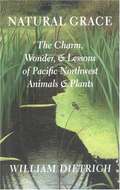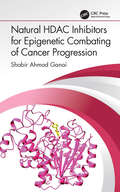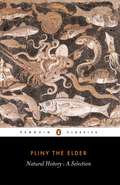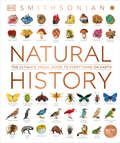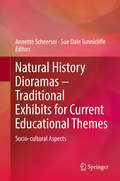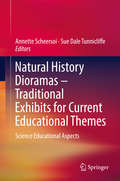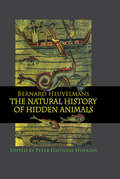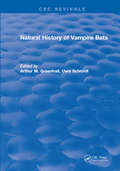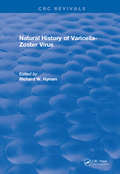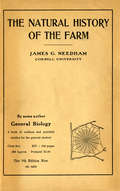- Table View
- List View
Natural Grace: The Charm, Wonder, and Lessons of Pacific Northwest Animals and Plants
by William DietrichThis informative and engaging selection of natural history essays is adapted from articles published in the Seattle Times magazine, Pacific Northwest. A native Washingtonian, Dietrich has watched the Northwest double in population during his lifetime. Our rapidly changing view of nature is an underlying theme throughout his wide-ranging essays, as is the timely and essential question of how best to share and conserve the natural world that drew us to the region in the first place.
Natural Gums and Resins: Botany and Sustainable Uses in Medicine, Nutrition, Perfumery and Cosmetics
by Niranjan Prasad Hartwig Schulz Victor Sam JayakumarTree resins such as mastic, gum arabic, frankincense and myrrh have been used for centuries all over the world. This book presents different fields of application for natural gums and resins in medicine, nutrition and cosmetics, taking some selected medicinal plant species as examples. It provides valuable information and a better understanding of the ecologically sustainable use of these globally significant plant raw materials. This is especially important for the processing industry. The contents include: Historical significance Cultivation Ecologically sustainable use Harvesting and trade Postharvest and storage management Processing for the pharmaceutical, cosmetic and perfume industry Protection and conservation of endangered species This book is of interest to researchers in botany and plant science, medicinal plants, pharmacy, chemistry and medicine, also practitioners in herbal and complementary medicine.
Natural HDAC Inhibitors for Epigenetic Combating of Cancer Progression
by Shabir Ahmad GanaiNatural HDAC Inhibitors for Epigenetic Combating of Cancer Progression deals only with HDAC inhibitors from natural origins including bacteria, fungi, marine organisms and, notably, from diverse plant sources. This book is unique in the sense that it is the only book that discusses wholly and solely HDAC inhibitors of natural origin in the context of cancer chemotherapy. Another peculiar feature of this book is that it debates futuristic nanotechnology approaches for escalating the aqueous solubility, cancer cell uptake, bioavailability and other favourable pharmacological parameters, including the cytotoxicity of natural HDAC inhibitors against cancer cells. The major features of this book encompass General compendium of HDAC inhibitors with deep emphasis on the toxicity issues of synthetic HDAC inhibitors Various groups of natural HDAC inhibitors, their representatives and premier sources Cyclic tetrapeptides of natural origin and their importance as cancer chemotherapeutic agents Hydroxamates and depsipeptides from natural sources and their promising role in cancer therapy Natural flavonoids, their HDAC inhibitory tendency and marvellous anticancer activity Non-flavonoid natural HDAC inhibitors and their pleasing cytotoxic effects towards cancer models Combined therapy involving natural flavonoids with other anticancer molecules for synergistic and additive benefits against cancer models Non-flavonoid HDAC inhibitors and conventional drugs in collaborative mode against aggressive malignancies Nanotechnology-based delivery of natural HDAC inhibitors for greater therapeutic efficacy over traditional combinatorial therapy This book is highly beneficial to university professors and research scholars working on epigenetic therapeutics in general, and natural HDAC inhibitors in particular. This book is equally important to medical oncologists, biochemistry as well as pharmacy candidates and students of master's and undergraduate level with a desire to do a doctorate on HDACs, natural HDAC inhibitors, HDAC inhibitor (natural)-based combinatorial chemotherapy and delivery of these inhibitors selectively to tumour sites through revolutionary nanotechnological tactics.
Natural Hazard Mitigation
by Alessandra Jerolleman John J. KieferOne of the four core phases of emergency management, hazard mitigation is essential for reducing disaster effects on human populations and making communities more resilient to the impacts of hazards. Presenting an up-to-date look at the changing nature of disasters, Natural Hazard Mitigation offers practical guidance on the implementation and selec
Natural History
by Pliny the ElderPliny's Natural History is an astonishingly ambitious work that ranges from astronomy to art and from geography to zoology. Mingling acute observation with often wild speculation, it offers a fascinating view of the world as it was understood in the first century AD, whether describing the danger of diving for sponges, the first water-clock, or the use of asses' milk to remove wrinkles. Pliny himself died while investigating the volcanic eruption that destroyed Pompeii in AD 79, and the natural curiosity that brought about his death is also very much evident in the Natural History - a book that proved highly influential right up until the Renaissance and that his nephew, Pliny the younger, described 'as full of variety as nature itself'.
Natural History (DK Definitive Visual Encyclopedias)
by DKA spectacular and exceptionally well-illustrated guide to everything on Earth. From rocks to redwoods and microbes to mammals – this is a dazzling visual introduction to our planet&’s treasures.Filled with more than 5,000 species and in-depth studies of animals, plants, fungi, microorganisms, rocks, and minerals, it&’s the ultimate celebration of the world&’s extraordinary diversity of life. Planet Earth's eclectic wildlife and endless wonders come to life in the most spectacular way in this monumental compendium of Earth&’s natural wonders. Compiled by a team of professional wildlife experts working with the world-renowned Smithsonian Institution, this comprehensive nature book was 5 years in the making!This unrivaled visual survey of Earth's natural history looks at every kingdom of life. It is packed with thousands of eye-popping, specially commissioned photographs and in-depth two-page spreads on incredible species. The engaging and informative text was supplied by a global team of natural history experts to make this bold visual encyclopedia a perfect addition to every family bookshelf or school library.From the evolution of nature to the classification of species, Natural History begins with a general introduction to life on earth. The next chapters form an extensive and accessible catalog of species and specimens – from flowering plants to reptiles – interspersed with fact-filled introductions to each group and in-depth profile features. A True Visual Dictionary of Earth's Natural WondersNatural History squeezes as many plants, animals, rocks, and minerals as possible between its covers. This extraordinary reference book from DK Books is eye candy for nature lovers of all ages, and makes a fantastic gift!Explore everything on Earth, such as: • Living earth • Minerals, rocks, and fossils • Microscopic life • Plants • Fungi • Animals
Natural History Collections in the Science of the 21st Century: A Sustainable Resource for Open Science
by Roseli PellensNatural history collections have recently acquired an unprecedented place of importance in scientific research. Originally created in the context of systematics and taxonomy, they are now proving to be fundamental for answering various scientific and societal questions that are as significant as they are current.Natural History Collections in the Science of the 21st Century presents a wide range of questions and answers raised by the study of collections. The billions of specimens that have been collected from all around the world over more than two centuries provide us with information that is vital in our quest for knowledge about the Earth, the universe, the diversity of life and the history of humankind.These collections also provide valuable reference points from the past to help us understand the nature and dynamics of global change today. Their physical permanence is the best guarantee we have of a return to data and to information sources in the context of open science.
Natural History Dioramas
by Sue Dale Tunnicliffe Annette ScheersoiThis book brings together in a unique perspective aspects of natural history dioramas, their history, construction and rationale, interpretation and educational importance, from a number of different countries, from the west coast of the USA, across Europe to China. It describes the journey of dioramas from their inception through development to visions of their future. A complementary journey is that of visitors and their individual sense making and construction of their understanding from their own starting points, often interacting with others (e. g. teachers, peers, parents) as well as media (e. g. labels). Dioramas have been, hitherto, a rather neglected area of museum exhibits but a renaissance is beginning for them and their educational importance in contributing to people's understanding of the natural world. This volume showcases how dioramas can reach a wide audience and increase access to biological knowledge.
Natural History Dioramas – Traditional Exhibits for Current Educational Themes: Science Educational Aspects
by Sue Dale Tunnicliffe Annette ScheersoiThis book focuses on socio-cultural issues and the potential of using dioramas in museums to engage various audiences with – and in – contemporary debates and big issues, which society and the natural environment are facing, such as biodiversity loss.From the early 1900s, with the passage of time and changes in cultural norms in societies, this genre of exhibits evolved in response to the changes in entertainment, expectations and expressed needs of museum visitors. The challenge has always been to provide meaningful, relevant experiences to visitors, and this is still the aim today. Dioramas are also increasingly valued as learning tools. Contributions in this book specifically focus on their educational potential. In practice, dioramas are used by a wide range of educational practitioners to assist learners in developing and understanding specific concepts, such as climate change, evolution or or conservation issues. In this learning process, dioramas not only contribute to scientific understanding and cultural awareness, but also reconnect wide audiences to the natural world and thereby contribute to the well-being of societies.In the simultaneously published book: “Natural History Dioramas – Traditional Exhibits for Current Educational Themes, Science Educational Aspects" the editors discuss the history of dioramas and their building and science learning aspects, as well as current developments and their place in the visitor experience.
Natural History Dioramas – Traditional Exhibits for Current Educational Themes: Science Educational Aspects
by Sue Dale Tunnicliffe Annette ScheersoiThis book presents the history of natural history dioramas in museums, their building and science learning aspects, as well as current developments and their place in the visitor experience. From the early 1900s, with the passage of time and changes in cultural norms in societies, this genre of exhibits evolved in response to the changes in entertainment, expectations and expressed needs of museum visitors. The challenge has always been to provide meaningful, relevant experiences to visitors, and this is still the aim today. Dioramas are also increasingly valued as learning tools. Contributions in this book specifically focus on their educational potential. In practice, dioramas are used by a wide range of educational practitioners to assist learners in developing and understanding specific concepts, such as climate change, evolution or or conservation issues. In this learning process, dioramas not only contribute to scientific understanding and cultural awareness, but also reconnect wide audiences to the natural world and thereby contribute to the well-being of societies.In the simultaneously published book: “Natural History Dioramas – Traditional Exhibits for Current Educational Themes, Socio-cultural Aspects” the editors focus on socio-cultural issues and the potential of using dioramas to engage various audiences with – and in – contemporary debates and big issues, which society and the natural environment are facing.
Natural History Of Hidden Animals
by HeuvelmansFirst published in 2007. Routledge is an imprint of Taylor & Francis, an informa company.
Natural History of Vampire Bats
by Arthur M. GreenhallA major problem with vampire bats is that whatever information exists is scattered throughout the literature or is not recorded. There are some excellent books on the ecology and biology of bats with very little on vampire bats. This volume fills that gap to provide an in-depth presentation of these unique animals.
Natural History of Varicella-Zoster Virus
by R.W. HymanThis book was first published in 1987. It comprises a natural history of the Varicella-Zoster virus, its clinical manifestations in humans, the molecular genetics, therapy and vaccinations.
Natural History of the Farm: A Guide to the Practical Study of the Sources of Our Living in Wild Nature
by James G. NeedhamThis is a guide to the practical study of the sources in wild nature of our living. It contains a series of study outlines for the entire year, and deals with both the plants and animals of the farm-the things that men have chosen to deal with as a means of livelihood and of personal satisfaction in all ages.
Natural History: A Selection (Classics Ser.)
by John F. Healey Gaius Plinius Secundus Gaius PlinyPliny’s Natural History is an astonishingly ambitious work that ranges from astronomy to art and from geography to zoology. Mingling acute observation with often wild speculation, it offers a fascinating view of the world as it was understood in the first century AD, whether describing the danger of diving for sponges, the first water-clock, or the use of asses’ milk to remove wrinkles. Pliny himself died while investigating the volcanic eruption that destroyed Pompeii in AD 79, and the natural curiosity that brought about his death is also very much evident in the Natural History – a book that proved highly influential right up until the Renaissance and that his nephew, Pliny the younger, described ‘as full of variety as nature itself’.
Natural Inflammatory Molecules in Fruits and Vegetables (SpringerBriefs in Molecular Science)
by Pasqualina Laganà Ramesh Kumar Sharma Maria Anna ConiglioThis book explores the role that some natural molecules found in fruits and vegetables, and their derivatives, play in excessive oxidation reactions that lead to inflammation in the human body. Particular attention is given to oxidation during food processing, especially when it comes to high-energy foods (derived from cereals) with notable amounts of oxidation-sensible lipids and protein chains. This book critically assesses the increased consumption of high-energy foods from a public health perspective. In addition, it provides an overview of the research into the unsaturated fatty acids and polypeptides responsible for nitric oxide production and elucidates the analytical identification of natural inflammatory molecules in fruits and vegetables. The book appeals not only to academic researchers and professors interested in public hygiene and food safety; medicine; food production; HACCP studies, but also to public health practitioners, and regulatory specialists and consultants.
Natural Interests: The Contest over Environment in Modern France
by Caroline FordChallenging the conventional trope that French environmentalism arose after WWII, Caroline Ford argues that a broad environmental consciousness emerged in France much earlier. In response to war, natural disasters, and imperialism, the bourgeoisie, along with politicians, engineers, naturalists, writers, and painters, took up environmental causes.
Natural Killer Cell Protocols
by Kerry S. CampbellAs the research has continued, it has become increasingly clear that natural killer (NK) cells are critical sentinels of the innate immune response, playing important roles in protecting the body from numerous pathogens and cancer in addition to contributing to normal pregnancy and impacting the outcomes of transplantation. While the first edition provided a valuable collection of classical cellular and in vivo techniques to study NK cell functions, the Second Edition of "Natural Killer Cell Protocols: Cellular and Molecular Methods" brings together more recently developed methods, more refined techniques, and detailed protocols designed to study NK cells within specialized tissue sites in both mice and humans. In this collection of methods, international leaders in the field cover topics ranging from the analysis of the various stages of NK cell development and maturation to specialized techniques for the identification of ligands for NK cell receptors. This volume also includes an appendix, providing a rich resource summarizing available reagents to study NK cells, cross-referencing KIR nomenclature, and detailing the many HLA ligands for various KIR family members. As a volume in the highly successful Methods in Molecular BiologyTM series format, chapters include introductions to their respective topics, lists of the necessary materials and reagents, step-by-step, readily reproducible laboratory protocols, and thorough notes sections, highlighting tips on troubleshooting and avoiding known pitfalls. Comprehensive and cutting-edge, "Natural Killer Cell Protocols: Cellular and Molecular Methods, Second Edition" seeks to aid researchers and further advance our understanding of the functions, maturation, and regulation of these fascinating and dynamic cells.
Natural Kinds and Classification in Scientific Practice (History and Philosophy of Biology)
by Catherine KendigThis edited volume of 13 new essays aims to turn past discussions of natural kinds on their head. Instead of presenting a metaphysical view of kinds based largely on an unempirical vantage point, it pursues questions of kindedness which take the use of kinds and activities of kinding in practice as significant in the articulation of them as kinds. The book brings philosophical study of current and historical episodes and case studies from various scientific disciplines to bear on natural kinds as traditionally conceived of within metaphysics. Focusing on these practices reveals the different knowledge-producing activities of kinding and processes involved in natural kind use, generation, and discovery. Specialists in their field, the esteemed group of contributors use diverse empirically responsive approaches to explore the nature of kindhood. This groundbreaking volume presents detailed case studies that exemplify kinding in use. Newly written for this volume, each chapter engages with the activities of kinding across a variety of disciplines. Chapter topics include the nature of kinds, kindhood, kinding, and kind-making in linguistics, chemical classification, neuroscience, gene and protein classification, colour theory in applied mathematics, homology in comparative biology, sex and gender identity theory, memory research, race, extended cognition, symbolic algebra, cartography, and geographic information science. The volume seeks to open up an as-yet unexplored area within the emerging field of philosophy of science in practice, and constitutes a valuable addition to the disciplines of philosophy and history of science, technology, engineering, and mathematics.
Natural Kinds and Conceptual Change
by Joseph LaporteAccording to the received tradition, the language used to to refer to natural kinds in scientific discourse remains stable even as theories about these kinds are refined. In this illuminating book, Joseph LaPorte argues that scientists do not discover that sentences about natural kinds, like 'Whales are mammals, not fish', are true rather than false. Instead, scientists find that these sentences were vague in the language of earlier speakers and they refine the meanings of the relevant natural-kind terms to make the sentences true. Hence, scientists change the meaning of these terms, This conclusions prompts LaPorte to examine the consequences of this change in meaning for the issue of incommensurability and for the progress of science. This book will appeal to students and professional in the philosophy of science, the philosophy of biology and the philosophy of language.
Natural Lactones and Lactams
by Tomasz JaneckiWhile there are numerous books on heterocycles and natural products, this text fills the need for an up-to-date summary focusing on recently developed and improved synthetic methods for the preparation of the most important classes of lactones and lactams - all in one volume. Comprehensive in its coverage, this book also provides readers with a brief description of the occurrence and biological or pharmaceutical activity of the compounds, and each chapter deals with a certain class of lactones or lactames to enable quick access to the information needed. A valuable resource for organic chemists, biochemists and medicinal chemists in academia and industry wanting to learn about successful synthetic routes leading to important natural products and use this as inspiration for their own work in the lab.
Natural Language Processing for Electronic Design Automation
by Rolf Drechsler Mathias SoekenThis book describes approaches for integrating more automation to the early stages of EDA design flows. Readers will learn how natural language processing techniques can be utilized during early design stages, in order to automate the requirements engineering process and the translation of natural language specifications into formal descriptions. This book brings together leading experts to explain the state-of-the-art in natural language processing, enabling designers to integrate these techniques into algorithms, through existing frameworks.
Natural Law in the Spiritual World
by Henry Drummond"No class of works is received with more suspicion, I had almost said derision, than those which deal with Science and Religion. Science is tired of reconciliations between two things which never should have been contrasted; Religion is offended by the patronage of an ally which it professes not to need; and the critics have rightly discovered that, in most cases where Science is either pitted against Religion or fused with it, there is some fatal misconception to begin with as to the scope and province of either. But although no initial protest, probably, will save this work from the unhappy reputation of its class, the thoughtful mind will perceive that the fact of its subject-matter being Law-a property peculiar neither to Science nor to Religion-at once places it on a somewhat different footing."
Natural Magic: Emily Dickinson, Charles Darwin, and the Dawn of Modern Science
by Renée BerglandA captivating portrait of the poet and the scientist who shared an enchanted view of natureEmily Dickinson and Charles Darwin were born at a time when the science of studying the natural world was known as natural philosophy, a pastime for poets, priests, and schoolgirls. The world began to change in the 1830s, while Darwin was exploring the Pacific aboard the Beagle and Dickinson was a student in Amherst, Massachusetts. Poetry and science started to grow apart, and modern thinkers challenged the old orthodoxies, offering thrilling new perspectives that suddenly felt radical—and too dangerous for women.Natural Magic intertwines the stories of these two luminary nineteenth-century minds whose thought and writings captured the awesome possibilities of the new sciences and at the same time strove to preserve the magic of nature. Just as Darwin&’s work was informed by his roots in natural philosophy and his belief in the interconnectedness of all life, Dickinson&’s poetry was shaped by her education in botany, astronomy, and chemistry, and by her fascination with the enchanting possibilities of Darwinian science. Casting their two very different careers in an entirely fresh light, Renée Bergland brings to life a time when ideas about science were rapidly evolving, reshaped by poets, scientists, philosophers, and theologians alike. She paints a colorful portrait of a remarkable century that transformed how we see the natural world.Illuminating and insightful, Natural Magic explores how Dickinson and Darwin refused to accept the separation of art and science. Today, more than ever, we need to reclaim their shared sense of ecological wonder.
Natural Materials and Products from Insects: Chemistry and Applications
by Dhiraj Kumar Mohammad ShahidThis book reviews the latest research on bioproducts from various economically important insects, such as silkworms, honey bees, lac and drosophila, and termites, and discusses their general, biomedical and industrial applications in detail. It includes chapters focusing on insects as a food source, probiotics, silk-based biomaterials, insect pheromones, insects as biomedicine source, pupa oil chemistry, non-protein compounds from Lepidopteran insects, insect chitin and chitosan, polyphenols and flavonoids.Model insects like Bombyx mori or bees were domesticated in Asian countries thousands of years ago. Over time, natural products from these animals became industrialized and today they attracting increasing attention thanks to their sustainability and their manifold applications in agriculture and biomedicine. The book is intended for entomologists, material scientists, natural product researchers and biotechnologists.
